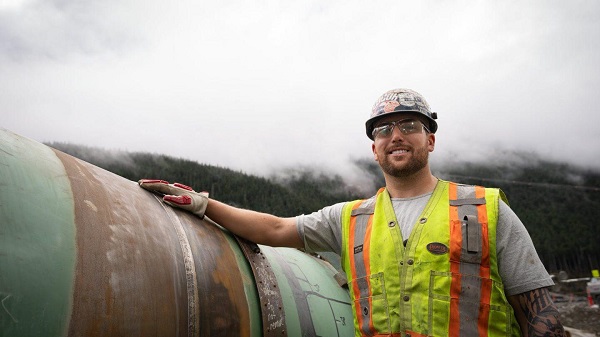Economy
Energy transition will be much longer and more arduous than they’re telling you

From the Fraser Institute
While many Canadian politicians and activists continue to trumpet the “energy transition” and conjure visions of a low-carbon future that supposedly lurks just around the corner, along comes Natural Resources Canada with its latest Energy Fact Book. A careful review of the publication pours cold water on any notion of a rapid shift to a fundamentally different energy system, one that features a much smaller role for the fossil fuels that now supply the vast majority of the energy used by Canadians.
The book contains a wealth of information on Canada’s large and notably diverse energy sector, covering production, consumption trends, investment, and the environmental impact of energy production and use. Separately, Natural Resources Canada also publishes “energy profiles” for the individual provinces and territories that provide further insight into energy production and consumption patterns across the country.
Starting with energy production (and considering all sources of energy, including uranium), crude oil accounts for about 45 per cent of Canadian energy output, measured in petajoules. Natural gas and natural gas liquids comprise another 32 per cent, with uranium chipping in 11 per cent of primary energy production. Smaller shares come from coal (5 per cent), hydroelectricity (5 per cent) and “other” renewables (3 per cent).
The statistics on energy output confirm that fossil fuels dominate the mix of energy sources produced in Canada. There’s little reason to believe this will change in a significant way in the near term.
Turning to energy consumption, a review of the most recent information leads to a broadly similar conclusion.
Based on Statistics Canada’s latest data, industry, collectively, is responsible for about 35 per cent of final end-use energy demand; this category includes manufacturing, natural resource extraction and processing, and construction. Transportation is the second-largest consumer of energy (29 per cent of final demand), followed by the residential (16 per cent) and commercial sectors (14 per cent).
What about the various sources of energy Canadians depend on for their comfort and well-being and to enable industrial and other business activity? Refined petroleum products rank first, providing about two-fifths of all energy consumed. Natural gas is second (35-36 per cent). Electricity comprises just 16-17 per cent of the energy used in Canada. Overall, fossil fuels still meet more than three quarters of Canadians’ requirements for primary energy.
Some may be surprised that electricity constitutes less than one-fifth of the energy used in Canada. A principal strategy of governments aspiring to slash greenhouse gas emissions is to redirect energy demand to electricity and away from oil, natural gas and other carbon-based energy sources. That makes sense, particularly since Canada’s existing electricity grid is about 80 per cent carbon-free. But a “big switch” to electricity won’t be easy. Consider that, over the first two decades of the millennium, Canadian natural gas consumption jumped by 34 per cent while electricity demand rose by 12 per cent. This underscores the resiliency of household and business demand for reliable affordable energy—of which natural gas is the best example.
Raising electricity’s share of total energy consumption will necessitate an enormous expansion across all segments of the Canadian electricity sector, encompassing not only the development of far more generation capacity but also the construction of additional transmission networks to deliver electric energy to end-users. Industry experts talk of boosting the amount of electricity produced in Canada by up to three times within two decades—a herculean task, assuming it’s even possible.
And, in line with the “net zero” goals espoused by many governments, virtually all of new electricity presumably must come from carbon-free sources (e.g., hydropower, other renewables, biomass, nuclear). There’s also the challenge of replacing the remaining carbon-based electricity still produced in Canada with carbon-free alternatives, as mandated by the Clean Electricity Regulations (CER) recently adopted by the Trudeau government.
Suffice to say the transition away from fossil fuels as the predominant source of energy consumed in Canada will be a lengthy and arduous journey and is sure to encounter more and bigger obstacles than most of Canada’s political class understands or cares to acknowledge.
Author
Business
The great policy challenge for governments in Canada in 2026

From the Fraser Institute
According to a recent study, living standards in Canada have declined over the past five years. And the country’s economic growth has been “ugly.” Crucially, all 10 provinces are experiencing this economic stagnation—there are no exceptions to Canada’s “ugly” growth record. In 2026, reversing this trend should be the top priority for the Carney government and provincial governments across the country.
Indeed, demographic and economic data across the country tell a remarkably similar story over the past five years. While there has been some overall economic growth in almost every province, in many cases provincial populations, fuelled by record-high levels of immigration, have grown almost as quickly. Although the total amount of economic production and income has increased from coast to coast, there are more people to divide that income between. Therefore, after we account for inflation and population growth, the data show Canadians are not better off than they were before.
Let’s dive into the numbers (adjusted for inflation) for each province. In British Columbia, the economy has grown by 13.7 per cent over the past five years but the population has grown by 11.0 per cent, which means the vast majority of the increase in the size of the economy is likely due to population growth—not improvements in productivity or living standards. In fact, per-person GDP, a key indicator of living standards, averaged only 0.5 per cent per year over the last five years, which is a miserable result by historic standards.
A similar story holds in other provinces. Prince Edward Island, Nova Scotia, Quebec and Saskatchewan all experienced some economic growth over the past five years but their populations grew at almost exactly the same rate. As a result, living standards have barely budged. In the remaining provinces (Newfoundland and Labrador, New Brunswick, Ontario, Manitoba and Alberta), population growth has outstripped economic growth, which means that even though the economy grew, living standards actually declined.
This coast-to-coast stagnation of living standards is unique in Canadian history. Historically, there’s usually variation in economic performance across the country—when one region struggles, better performance elsewhere helps drive national economic growth. For example, in the early 2010s while the Ontario and Quebec economies recovered slowly from the 2008/09 recession, Alberta and other resource-rich provinces experienced much stronger growth. Over the past five years, however, there has not been a “good news” story anywhere in the country when it comes to per-person economic growth and living standards.
In reality, Canada’s recent record-high levels of immigration and population growth have helped mask the country’s economic weakness. With more people to buy and sell goods and services, the overall economy is growing but living standards have barely budged. To craft policies to help raise living standards for Canadian families, policymakers in Ottawa and every provincial capital should remove regulatory barriers, reduce taxes and responsibly manage government finances. This is the great policy challenge for governments across the country in 2026 and beyond.
Business
Dark clouds loom over Canada’s economy in 2026

From the Fraser Institute
The dawn of a new year is an opportune time to ponder the recent performance of Canada’s $3.4 trillion economy. And the overall picture is not exactly cheerful.
Since the start of 2025, our principal trading partner has been ruled by a president who seems determined to unravel the post-war global economic and security order that provided a stable and reassuring backdrop for smaller countries such as Canada. Whether the Canada-U.S.-Mexico trade agreement (that President Trump himself pushed for) will even survive is unclear, underscoring the uncertainty that continues to weigh on business investment in Canada.
At the same time, Europe—representing one-fifth of the global economy—remains sluggish, thanks to Russia’s relentless war of choice against Ukraine, high energy costs across much of the region, and the bloc’s waning competitiveness. The huge Chinese economy has also lost a step. None of this is good for Canada.
Yet despite a difficult external environment, Canada’s economy has been surprisingly resilient. Gross domestic product (GDP) is projected to grow by 1.7 per cent (after inflation) this year. The main reason is continued gains in consumer spending, which accounts for more than three-fifths of all economic activity. After stripping out inflation, money spent by Canadians on goods and services is set to climb by 2.2 per cent in 2025, matching last year’s pace. Solid consumer spending has helped offset the impact of dwindling exports, sluggish business investment and—since 2023—lacklustre housing markets.
Another reason why we have avoided a sharper economic downturn is that the Trump administration has, so far, exempted most of Canada’s southbound exports from the president’s tariff barrage. This has partially cushioned the decline in Canada’s exports—particularly outside of the steel, aluminum, lumber and auto sectors, where steep U.S. tariffs are in effect. While exports will be lower in 2025 than the year before, the fall is less dramatic than analysts expected 6 to 8 months ago.
Although Canada’s economy grew in 2025, the job market lost steam. Employment growth has softened and the unemployment rate has ticked higher—it’s on track to average almost 7 per cent this year, up from 5.4 per cent two years ago. Unemployment among young people has skyrocketed. With the economy showing little momentum, employment growth will remain muted next year.
Unfortunately, there’s nothing positive to report on the investment front. Adjusted for inflation, private-sector capital spending has been on a downward trajectory for the last decade—a long-term trend that can’t be explained by Trump’s tariffs. Canada has underperformed both the United States and several other advanced economies in the amount of investment per employee. The investment gap with the U.S. has widened steadily since 2014. This means Canadian workers have fewer and less up-to-date tools, equipment and technology to help them produce goods and services compared to their counterparts in the U.S. (and many other countries). As a result, productivity growth in Canada has been lackluster, narrowing the scope for wage increases.
Preliminary data indicate that both overall non-residential investment and business capital spending on machinery, equipment and advanced technology products will be down again in 2025. Getting clarity on the future of the Canada-U.S. trade relationship will be key to improving the business environment for private-sector investment. Tax and regulatory policy changes that make Canada a more attractive choice for companies looking to invest and grow are also necessary. This is where government policymakers should direct their attention in 2026.
-

 Energy19 hours ago
Energy19 hours agoThe U.S. Just Removed a Dictator and Canada is Collateral Damage
-

 Haultain Research16 hours ago
Haultain Research16 hours agoTrying to Defend Maduro’s Legitimacy
-

 Business1 day ago
Business1 day agoVacant Somali Daycares In Viral Videos Are Also Linked To $300 Million ‘Feeding Our Future’ Fraud
-

 International1 day ago
International1 day ago“Captured and flown out”: Trump announces dramatic capture of Maduro
-

 International24 hours ago
International24 hours agoTrump Says U.S. Strike Captured Nicolás Maduro and Wife Cilia Flores; Bondi Says Couple Possessed Machine Guns
-

 International18 hours ago
International18 hours agoU.S. Claims Western Hemispheric Domination, Denies Russia Security Interests On Its Own Border
-

 International19 hours ago
International19 hours agoUS Justice Department Accusing Maduro’s Inner Circle of a Narco-State Conspiracy
-

 International2 days ago
International2 days agoMaduro says he’s “ready” to talk











